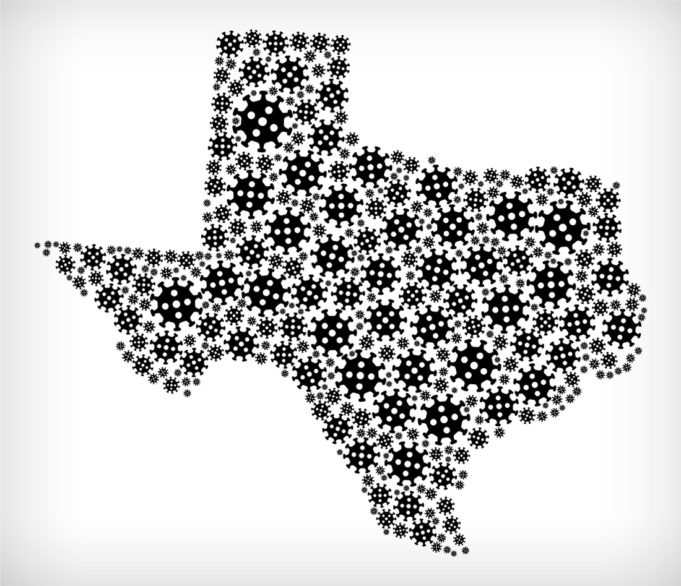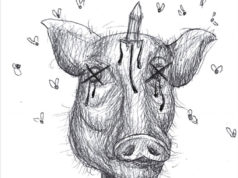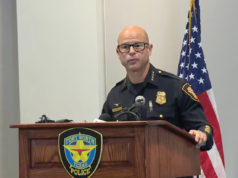We have a lot of hospital beds but no vaccine. So. Business as usual.
That’s the message from Gov. Greg Abbott as cases of COVID-19 in Texas continue to surge at a time when all businesses statewide are at least 50% open.
The governor recently told KYTX-TV in Tyler that there’s “no real need” to dial back reopening because “we have so many hospital beds available to anybody who gets ill.”
For people who get sick, a hospital bed does not guarantee recovery from the novel coronavirus.
And most of the infirmed won’t be only seniors. Increasingly, young people are testing positive, which is why Abbott went out of his way recently to scold them for not taking safety precautions seriously, especially when twentysomethings are going out to the places he’s reopened.
“A lot of people have let down their guard,” the governor said on KLBK-TV in Lubbock. “The summer’s here. Things are opening up. [People] feel like they can go out without having to wear a face mask, and they are not realizing this very important fact: COVID-19 still exists in Texas, in America, and across the globe.”
If you do not wear a face covering, wash your hands, or maintain a safe distance from others when out in public, he warned, “you will test positive.”
Infections among people between the ages of 20 and 29 are going up at a “record pace,” he told KRGV-TV in McAllen, basing his statement on the data available to him from health departments and county judges around the state.
Daily coronavirus cases and hospitalizations in Texas for all demographics have been breaking records. Though not unexpected, the increases mean we are at a critical juncture, according to numerous public health experts. Where we go from here depends on, well, you. Should you stay home and be safe or not wear a face mask or practice social distancing and go out to the places Abbott has reopened and risk contracting a deadly illness?
“Social distancing works,” said Dr. Erin Carlson, associate clinical professor and director of Graduate Public Health Programs in the College of Nursing and Health Innovation at UTA. “It is one of the oldest methods we have to curb disease spread, having been used widely in the 1918 Flu Pandemic and even prior to that event. Further, we know that the aerosolized droplets we produce when coughing, talking, or sneezing do not usually travel beyond 6 feet. Hence, the guidelines of social distancing are based on science and work well to curb disease spread when they are followed.
“The problem we are seeing with a rise in cases in Texas,” she continued, “is not because the science of social distancing doesn’t work. It is because social distancing isn’t being practiced. ‘Social distancing’ means staying home as much as possible, avoiding gatherings, and staying at least 6 feet away from other people when we must go to public places. Clearly, that definition of social distancing does not describe much of the behavior we are currently witnessing since Texas reopened.”
The latest Tarrant County woman to die from COVID-19 had no underlying conditions. She was the 198th person to be claimed by the coronavirus.
There are 7,642 confirmed cases of COVID-19 in Tarrant County, according to health officials. The recoveries number 3,299.
For the week beginning June 7, 1,188 new coronavirus cases were confirmed by Tarrant County, the most yet. The second highest was 1,118 for the week beginning May 3.
In a press conference Tuesday, Abbott said that on the same day Texas reported a new single-day high of 2,622 COVID-19 new cases, the number of patients hospitalized reached an all-time high of 2,518 patients.
Though Abbott said he’s a little concerned about those precious beds, he’s not worried about much else. “There is no reason right now to be alarmed.”
More people are being tested, it’s true. Though Austin has been unable to meet its promised 30,000 daily tests consistently, testing has increased a modest 7% since May. That still doesn’t explain the rising infection rate. The infection rate, or how many people are testing positive out of the total number tested, has been trending upward since late May. On May 26, the state’s seven-day average infection rate was 4.27%. Last Thursday, it was 7.05%.
After declining throughout May, the number of hospitalizations in Tarrant County has also begun to rise. Along with more infections at high-risk areas like meatpacking plants, nursing homes, and prisons and with more people going out — more young people, it seems, because what are they gonna do? stay home and knit? (not that there’s anything wrong with that) (actually, that sounds pretty awesome) — Memorial Day shindigs are partly to blame for the higher numbers.
“Clearly,” Dr. Carlson said, “when there is mass testing at a site,” like a meatpacking plant, nursing home, or prison, “a jump in reported local cases will result. However, the overarching increase in cases we are seeing in Texas cannot be attributed to one place or mass-testing event. The increase in cases is occurring in cities throughout Texas and during a similar timeframe. This indicates an overall increase in cases not attributable to one facility or business. It may be that the reopening of Texas has led some people to believe that it is safe to proceed with life as usual without employing social distancing, mask wearing, and sanitizing. However, these three measures are still expected and encouraged by the state and local governments and health officials.”
Some are already pointing fingers at the protests, blaming them for the increases, when in fact we will not know the effects of the protests until several weeks from now.
Does Dr. Carlson believe we’ll have to go into another lockdown?
“I cannot speak from an economic perspective. From a public health perspective, we know that the quickest means to curbing an outbreak is sheltering in place. However, once the stay-at-home orders were lifted and reopening occurred, health policy leaders have suggested that, whether or not renewed stay-at-home orders are in the best interest of public health, re-instatement of such orders may be politically untenable. It remains to be seen how Texas lawmaker will weigh economic concerns against public health concerns.”
The mayors of nine large Texas cities, including Fort Worth, recently petitioned Abbott to make mask wearing mandatory. On Tuesday, the governor said he does not want to penalize people for not wearing masks in public.
“A study published this month found that wearing a mask reduces COVID transmission by 80%,” Dr. Carlson said. “Masks were found to be as effective in the community environment as in healthcare environments. The same study found that maintaining at least a meter of distance between people reduced transmission by 82%. As such, if we want to curb the epidemic, prevent hospitals from being over-burdened, and save lives, lawmakers should seriously consider science in their decisions about mask requirements and social distancing.”
Or we can just stop testing. Like the math genius in the White House has said: testing fewer people equals fewer positive results.
In a way, Abbott’s ploy is pretty ingenious. He’s a lawyer, remember, so it makes sense that he would shift the blame away from himself and to the Texans he has sworn to protect. — Anthony Mariani
The Weekly welcomes submissions from all political persuasions. Please email Editor Anthony Mariani at anthony@fwweekly.com.












